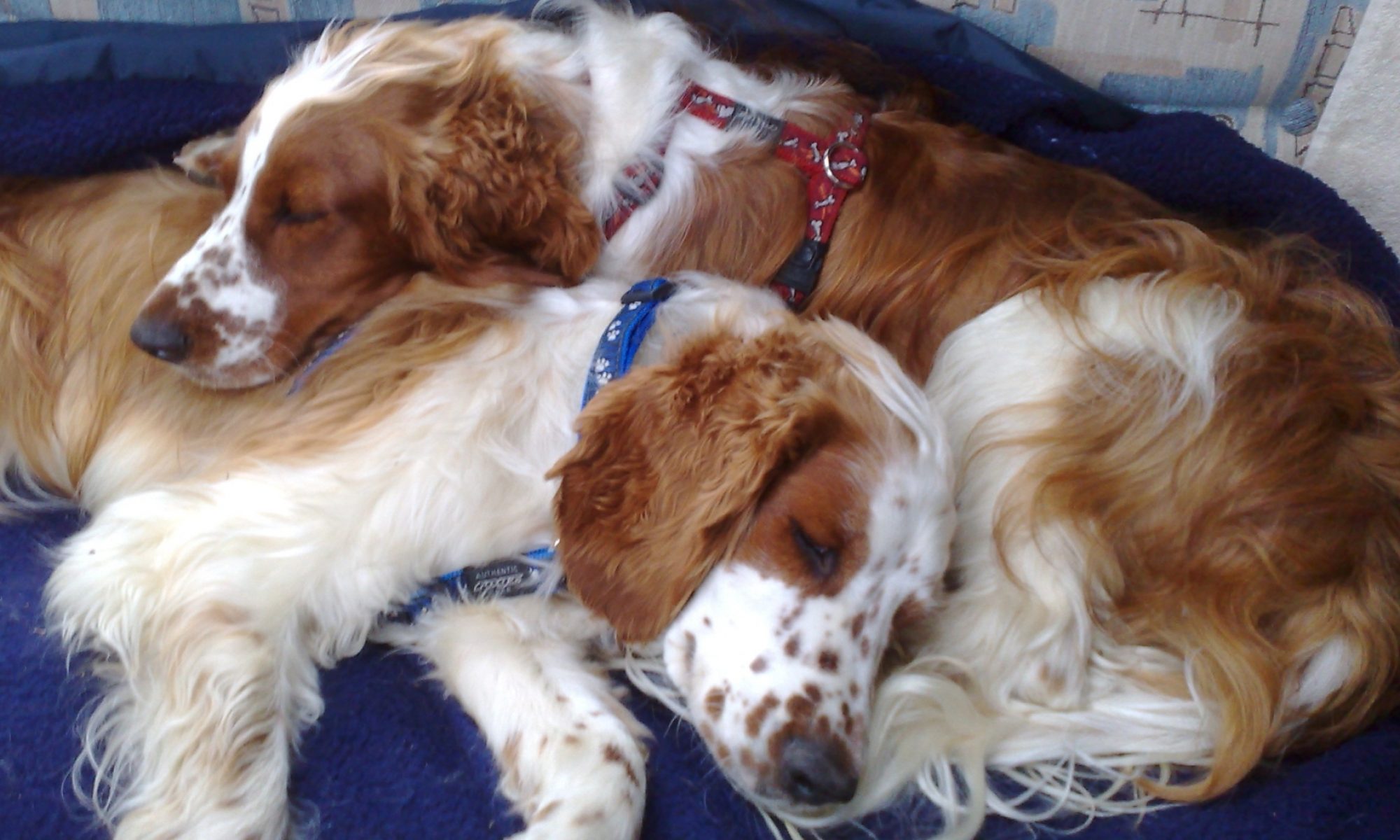The Dog's Digestive System
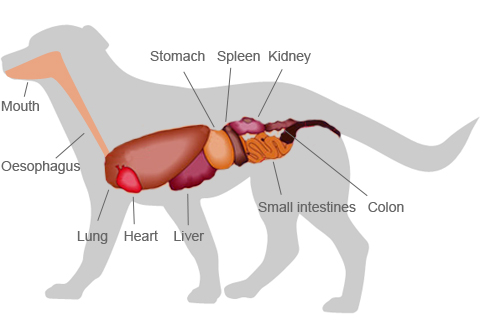
The gastrointestinal (GI tract) comprises of the following:
Mouth
Oesophagus
Stomach
Small intestine
Large intestine (colon)
Pancreas
Liver
Biliary Tract
The domestic dog’s anatomy and morphology and physiology show us that he is suited to eating raw meat and bones in the following way:
Mouth and Stomach
Mouth, Teeth and Jaw
The mouth and teeth are at the very start of the dog’s digestive system. The dog’s mouth and teeth are designed to bite off and chew large pieces and to eat quickly and to crunch bone. Canine teeth tear, cut or slice meat to the correct size, molars crunch bones, and overall the bite pressure of the jaw is excellent.
Dogs have hinged jaws and large teeth and can open up their throat – this is designed to allow them to swallow large chunks of meat, bones and fat products that are usually part of the dog’s diet, leaving the stomach to do all the work beyond removing and crunching up a piece of meat and bone.
A dog’s jaw only goes in one direction – up and down. This compares with that of a herbivore, whose jaw goes from side to side to crush vegetation. Omnivores (such as humans) have jaws that can do both.
The mouth contains salivary glands that secrete saliva – saliva adds water to the food to help it pass through the digestive tract. It also contains bicarbonate and proteins that start digestion and help to transport Vitamin B12.
Dogs do not produce the digestive enzyme amylase (which aids the breakdown of carbohydrates) in their saliva. For carnivores, the burden of digesting carbohydrates is placed entirely on the pancreas.
Dogs have taste buds that recognise ‘sweet’ flavours, which suggests that berries and other seasonally available fruit may have supplemented the dog’s ancestral diet.
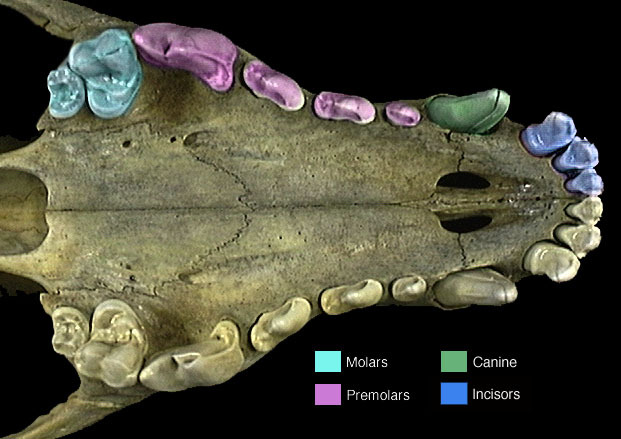
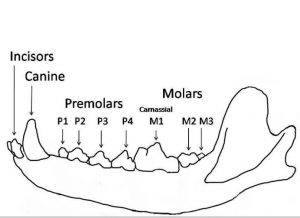
Oesophagus
The oesophagus is the tube that connects the mouth to the stomach. It is a muscle and on contracts in wave like motions (called peristalsis) to move the food along the path to the stomach.
The oesophagus has a tight sphincter muscle where it meets the stomach – this is a ring of thick muscle that acts as a door. It prevents acid reflux or movement of acid from the stomach back up into the oesophagus.
Stomach
The stomach is made of 5 chambers – cardia, fundus, corpus (or body), antrum and pylorus. The cardia, fundus and first third of the corpus continuously contract, whilst the rest of the corpus, the antrum and the pylorus turn the food into small pieces. The stomach takes a very active part in the digestive process when raw meat and bones are fed. It ‘grinds’ and releases acid as it does so, breaking the food down into a very thick liquid called chyme. The pyloric valve ensures that only liquids can pass through into the duodenum.
The lining of the dog’s stomach contains millions of gastric pits which secrete a number of important substances:
Hydrogen and chloride for hydrochloric acid
Pepsinogen
Lipase
Intrinsic factor
Mucus
Ghrelin
The environment in the dog’s stomach is extremely acidic, about 1-2pH. This is way more acidic than human stomach acid, which is about 5pH - the hydrochloric acid in a dog’s stomach would burn your hand if you were to touch it. This high level of hydrochloric acid allows the breakdown of the large pieces of protein and the bones that the dogs ingest and kills most harmful bacteria.
Pepsinogen converts to pepsin - pepsin is active at a pH of about 1-2 and breaks down the peptide bonds in amino acids (the start of protein digestion).
Lipase is a digestive enzyme that initiates fat digestion.
Intrinsic factor is a specialised protein that binds with and transports Vitamin B12 to the colon, where it is absorbed into the body.
The lining of the stomach is covered with a thick mucus to prevent the stomach from digesting itself (due to the strong acid) and it also prevents unwanted substances from travelling across the gut lining.
Ghrelin is a hormone that is released to influence the release of growth hormones and to stimulate the appetite and fat deposits.
Dogs also have a natural regurgitation instinct which allows them to spit out food that has not been processed correctly, and then to re-swallow it.
The stomach also serves as a short-term storage area, allowing the dog to consume a large meal quickly and processing it over a longer period of time. Typically, a dog’s stomach can hold around 7-8% of its body weight.
Food doesn’t actually get absorbed from the stomach (with the exception of alcohol and some drugs like aspirin) – the purpose of the stomach is to start digestion but most digestion and nutrient absorption takes place in the small intestine.
The length of time food spends in the stomach of a carnivore is about 4-8 hours, whereas in an omnivore food only spends around 30 plus minutes in the stomach. Carbohydrates are emptied faster than protein, which is emptied faster than fats. Emptying is delayed when the pH of the stomach is alkaline.
When kibble is fed, the stomach has a much more sedate role which means it becomes out of practise through a lack of work, and as the stomach regulates acidity based on what we feed, with kibble the pH of the body is much higher than the optimum pH for health and the bacteria that promotes this.
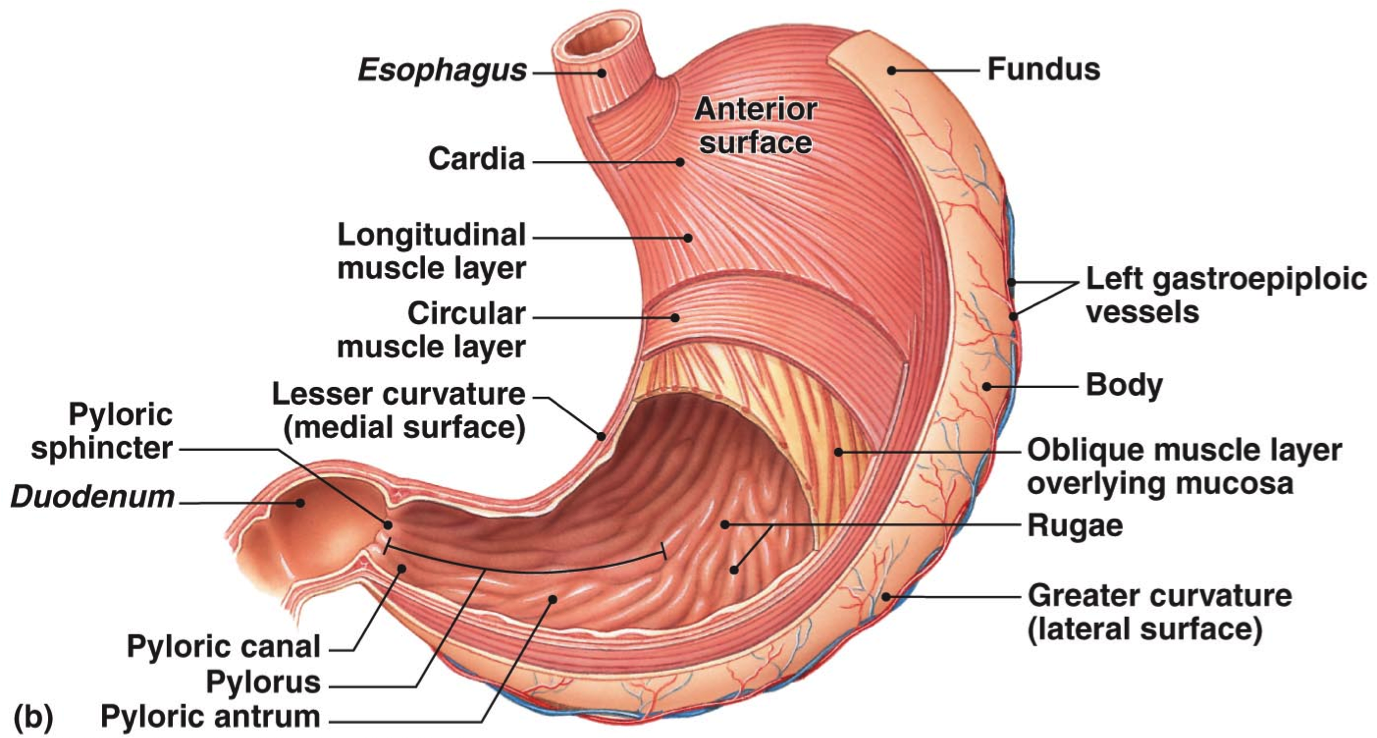
The Small & Large Intestine
Pancreas
The pancreas is a gland, it is an organ that secretes chemicals. It is a V-shaped organ that is located behind the stomach and the first section of the small intestine, the duodenum. It has two main functions:
As an endocrine gland that aid in the metabolism of sugar in the body through the production of insulin and glucagon
To assist in the digestion of nutrients by producing pancreatic enzymes that break down food. These pancreatic enzymes are secreted into the small intestine. Different mechanisms produce different enzymes – for example, eating fat stimulates a different enzyme than eating protein.
Pancreatitis occurs when the pancreas becomes inflamed (tender and swollen).
Liver
The liver is the largest organ in the body aside from the skin, and it is the largest gland. The liver plays a key role in detoxification, manufacturing protein, producing chemicals needed for digestion – it actually plays more than 500 roles in the body.
The liver produces bile, breaks down fats for digestion, stores carbohydrates in the form of glycogen, and stores fat-soluble vitamins (A, D, E, K and B12) and minerals (iron, copper and magnesium).
Biliary Tract
The biliary tract is a system of organs and ducts that produce and transport bile. Bile is secreted in the liver, where it’s collected in a system of ducts that connect with the gallbladder. It ultimately runs to the duodenum (1st section of the small intestine).
Bile that leaves the liver can either drain the liver as waste products (dark brown colour) or it can travel to the gallbladder where it is stored (greenish-yellow fluid) and then released into the duodenum when food is digested. Bile salts help break down fat in the diet.
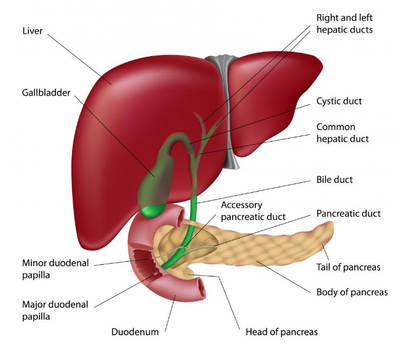
Small Intestine
The main part of the digestion process occurs in the small intestine – this is where the liquid produced by the stomach is assimilated into nutrients and absorbed into the blood.
The small intestine is divided into 3 segments:
Duodenum – connects to the stomach
Jejunum – the middle part
Ileum – attaches to the colon
The intestines are lined with a mucus membrane to prevent the acid from digesting the intestines themselves and to also prevent abrasion from food and bone particles.
The lining of the small intestine has millions of villi – these villi increase the surface area of the small intestine to better assimilate and absorb nutrients. In between the villi are crypts, which secrete water and electrolytes into the intestines to keep the chyme liquid.
The wall of the small intestine is quite thin, and this allows for digested food to pass through either by diffusion or by biochemical processes activated within the cells. Once digested food passes through the wall, it travels in the blood to the liver or to other parts of the body as needed. However, undigested food never passes through the wall of the intestine.
The small intestine is a long hollow tube about 4 times the length of the dog’s body. Within the small intestines there are openings that let digestive juices enter from the pancreas and the gallbladder. The pancreas secretes enzymes that help to further break down proteins, carbohydrates and fats, and is also an endocrine gland that regulates blood sugar. The gallbladder stores and regulates the release of bile – bile is needed to break down fats.
In addition to absorbing food particles, the small intestine also absorbs other materials such as water, electrolytes and other molecules. The small intestine plays an important role in water and acid-base balance.
As the intestinal system is shorter than that of a human (approx. 4 times the body length in the dog compared to 10-11 times the length in a human), the pH in the digestive process system is low and the digestive system is fast acting to digest proteins, this indicates that the dog is suited to eating meat on a physiological level – indeed, the digestive system is specifically made for processing raw meat as a faster passing time is needed for all the meat protein eaten. Carbohydrates and fibres require a longer digestion process.
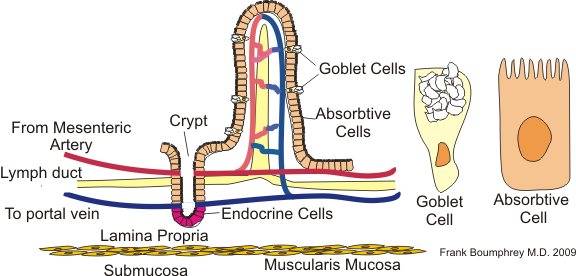
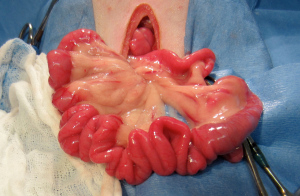
Large Intestine
Any leftover undigested content from the small intestine is transferred into the large intestine (the colon). The large intestine doesn’t digest food, but it does have some important functions - this is where water and mineral electrolytes are recovered from the food that is passing through and hydration in the body is kept at a constant level.
The large intestine contains bacteria that produces enzymes to help break down the very last, hard to digest material, producing fatty acids and vitamins. The large intestine also protects against pathogens by secreting mucus to protect the large intestine lining from bacteria and viruses and bile, and digestive enzymes also help to kill the bacteria and viruses. The good bacteria also produce substances that can be toxic to harmful bacteria, and the continuous movement of the large intestine discourages toxins from entering the body and eliminates them from the gastrointestinal tract.
Faeces are then formed and stored, to await exit through the rectum.
Food digestion
Protein
Protein digestion begins in the stomach, which produces the enzyme pepsin. Pepsin is released when there is protein in the stomach and the stomach pH is low.
Protease is released from the pancreas into the small intestine to break down protein. The amino acid bonds are broken to make free amino acids – only these free amino acids can pass through the intestinal lining and be transported into the liver. The liver uses the amino acids in one of three ways:
Manufacture new tissues or non-essential amino acids
Used by the liver to make enzymes and plasma proteins
Free amino acids can be used for energy
The body can only synthesize new proteins and enzymes if all of the amino acids are available.
Proteins are stored in the muscles and tissues, but protein needs to be digested every day.
The metabolism of proteins produces waste in the form of nitrogen and ammonia, which are toxic to the cells in the body. Most of the ammonia is produced by the liver and kidneys where it is converted to urea and excreted in the urine.
Dietary Fats
Dietary fats include triglyceride, cholesterol and the fat soluble vitamins.
Stomach releases gastric lipase to start the digestive process, which is then completed in the small intestine by pancreatic lipase (released by the pancreas) and bile salts. However, short chain fatty acids aren’t digested in the small intestine – this is done by the bacteria that helps ferment fibre in the diet in the large intestine.
All fatty acids are transported to liver, where hormones then determine what happens. Fatty acids can be converted to glycerol (used to produce glucose) whilst excess fatty acids are stored as fat for future energy needs.
Carbohydrates
Carbohydrates (also known as saccharides) are not required in the diet, although they can be a source of energy. Not all carbohydrate is digestible – fibre such as cellulose and bran pass right through the digestive tract whilst some fibre can feed the bacteria that live in the large intestine. Fibre also slows down the progression of food along the digestive tract.
Carbohydrate digestion begins in the stomach, where the stomach acids begin to break the carbohydrates down. In the small intestine, the pancreatic digestive enzyme amylase breaks the complex carbohydrates down into smaller chains. Following this, the digestive enzymes maltase, sucrase and isomaltase break the smaller chains into simple glucose molecules, which can pass through the intestinal wall. The enzyme lactase splits lactose (the sugar found in milk) into glucose and galactose.
Glucose travels from the small intestine into the liver, and the liver decides how the glucose will be used or stored. The effect that carbohydrates in the diet have on blood glucose is called the glycemic index.
Unlike most other tissues in the body (which can use fatty acids or proteins as fuel), the brain and central nervous system can only use glucose.
Excess glucose is converted to fatty acids and stored as fat.
Vitamins
Fat soluble Vitamins, together with B12, are absorbed by bile produced in the liver. The water soluble vitamins are easily absorbed via the small intestinal wall, and large amounts will also be stored in the liver.
Other Considerations
Livers in dogs are larger to process proteins and nitrogenous wastes.
The dog actually has the shortest digestive system of mammals and it takes roughly 8-9 hours for the whole digestive process (less in puppies as their digestive system is not so mature).
Carbohydrates can be well tolerated and incorporated as part of a healthy diet as amylase (used to digest cellulose and plant matter) is produced by the pancreas.
The Microbiome
The dog’s intestines contains a world of micro-organisms that play a critical role in health and disease, but there is little understanding of how they work. It is speculated that they work together with the body’s cells, fungi, yeast, viruses and single-cell organisms – this is the microbiome. Microbiomes also live in soil, water and other parts of the body; they can be found on all internal and external surfaces of the body including eyes, skin, ears, mouth, throat and airways, forming a mutually beneficial relationship with the animal they live in.
The microbiome plays such a huge role in the health of the animal that it’s been called the ‘forgotten organ’. It is rapidly renewable and adaptable.
The microbiome produces molecules that have antibiotic, antiviral and antifungal properties, protecting the host against pathogens that may enter through the mouth. It slow the growth of pathogenic or harmful bacteria by competing for nutrients and attachment sites. It is an important barrier to carcinogens, drugs, heavy metals, toxins and potential allergens, either destroying them or holding them until they are passed from the body.
The microbiome helps produce enzymes for digestion and to release vitamins, minerals and other nutrients into the body. It produces water soluble B vitamins as well as digestive and protective enzymes which help with digestion. It helps transport nutrients through the gut lining into the body.
The microbiome can change the generic expression of cells and it can ferment fibre into short chain fatty acids (SCFAs) which help the body absorb nutrients such as calcium, magnesium and iron.
However, the most important role of the microbiome is to train and support the immune system.
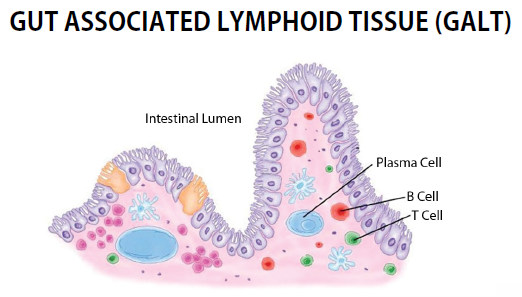
The lymphoid tissue found specifically in the small intestines is called the Galt – this is the largest immune organ in the body and it combines with the microbiome to contribute up to 90% of the body’s total immune capacity.
The galt contains lymphocytes such as B cells and T cells – these are the main workers in the immune system.
Large amounts of starch in the diet, sterile and processed foods, prolonged periods of stress, infection, radiation, the use of antibiotics and other drugs, GM foods, conventional dairy products, sugars, lactams, preservatives, artificial colours and chlorinated water can all disrupt the microbiome in the gut. This damage is called dysbiosis (or leaky gut), and occurs when pathergenic bacteria start to overgrow – the gut tissue becomes inflamed and this can cause the intestinal cells to separate, allowing pathogens, bacteria and undigested proteins to pass through and enter the blood stream. The immune system recognises the foreign matter and ramps up to neutralises the foreign invaders; however if the foreign protein looks like one of the body’s own tissue proteins (molecular mimicry) it can cause the body to create antibodies against itself, leading to autoimmune diseases.
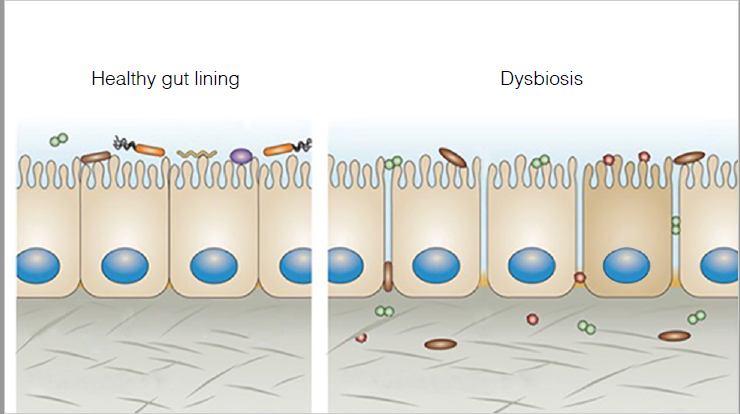
Some studies show a relationship between the microbiome and mood.
Imbalanced gut microbiome can also lead to yeast infections – yeast is a type of fungus that thrives in simple sugars. Candida Albicans (yeast entering the body) is often misdiagnosed as allergies because of the skin issues that it can cause.
The lack of probiotics and prebiotics in processed foods can also cause dysbiosis in dogs.
Return to Nutrition General | Return to The Canine Body | Return to Digestive System
